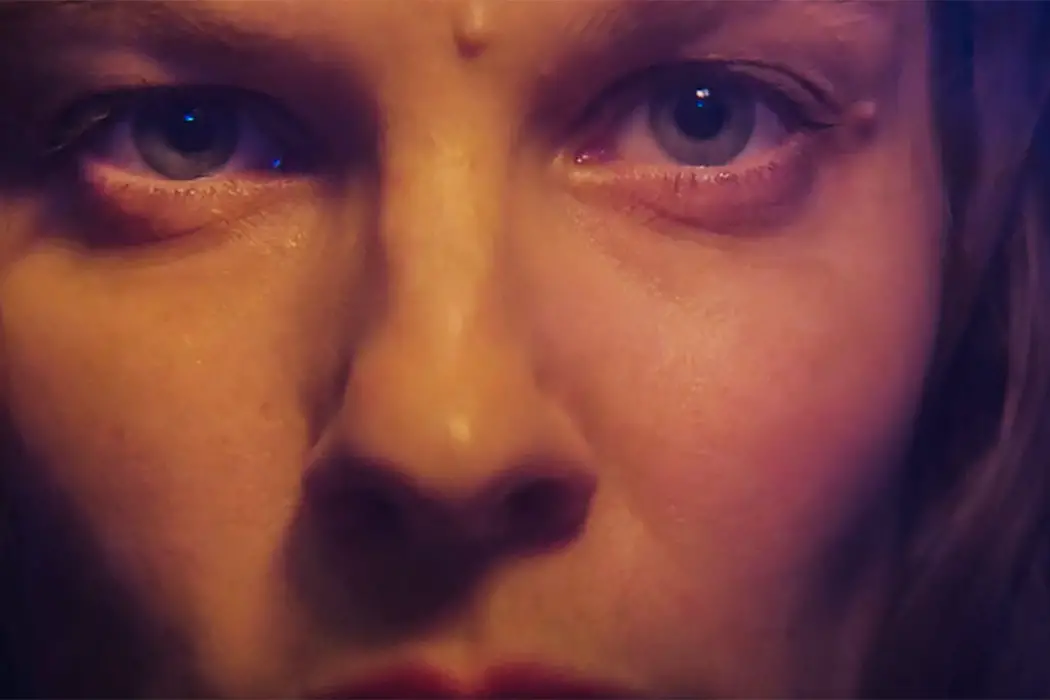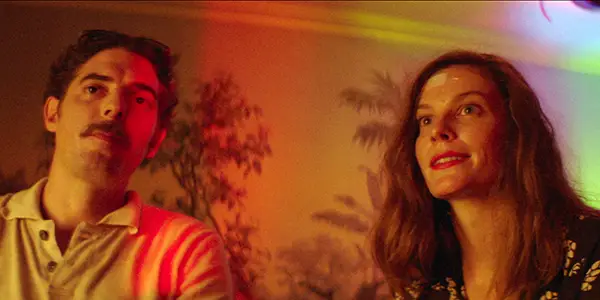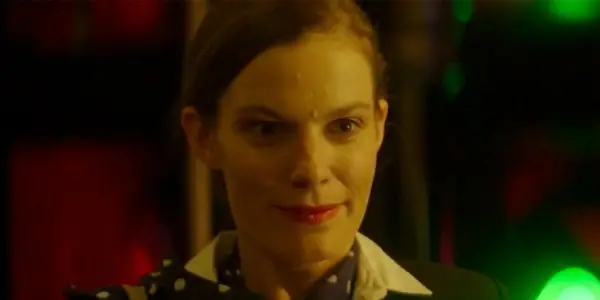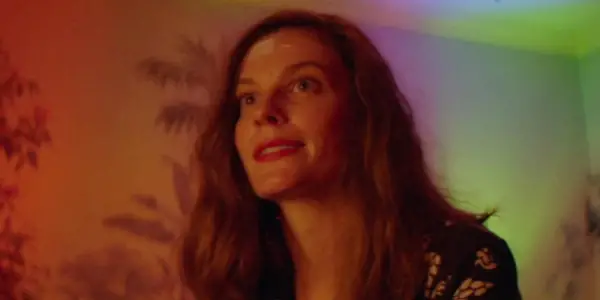THIRST STREET: Lacking In Character, But Not In Style

It took me a while to discover the wonderful world…
How much style does a film need to make up for a lack of substance? The answer to that question is different for everyone. Some think Nicholas Winding Refn is a genius, others think he’s a lurid hack. Some think Terrence Malick understands the visual language of cinema like no one else, others think he’s pretentious and weirdly obsessed with cornfields. There’s no right answer, just different tastes and levels of tolerance for the artistic visions of certain filmmakers.
Nathan Silver may not be as big a name as Refn or Malick, but Thirst Street, his seventh film in nine years, is bound to elicit similar debates.
Thirst Street
Gina (Lindsay Burdge) is an air hostess who has never had much luck with men. When she finally does get a boyfriend, and he kills himself after the latest of her long, career-necessitated absences, a Parisian layover sends her spiralling into the bed of barman Jérôme (Damien Bonnard) for a queasy night of lovemaking.

When the morning comes, he is ready to say a cheery farewell, but Gina sees their night together as the start of something, rather than a one-off. On her next Parisian layover, she seeks out Jérôme, and they sleep together once more. But this time Gina does not go home afterwards. With nothing left for her in America, she decides to make the move to Paris to spend more time with her ‘new man’. Not invested enough to want a confrontation, Jérôme does not put up much of a fight. But as Gina’s unhinged behaviour escalates, and starts impacting his relationship with Clémence (Esther Garrel), the woman he really loves, he begins to regret his lack of action.
Gina
Cinema is full of ‘crazy’ jealous women. In recent years, there’s been an array of takes on the Fatal Attraction ‘bunny-boiler’ in films like Obsessed, You Get Me, and Unforgettable.
What makes Thirst Street stand out in this trashy sub-genre is that you are invited to sympathise with Gina. The pre-credits sequence tells a story that instantly places you on her side. How do you not feel for a lonely woman who lost her one true love to suicide? Angelica Huston‘s wry narration describes the world almost exclusively from Gina’s point of view – often we can see that events are not happening the way that she thinks they are, but that inspires sympathy, rather than revulsion.
This is mainly shown, of course, in the relationship with Jérôme. With his sleazy demeanour and unfortunate mustache, the fact that she chose him as her Prince Charming in the first place shows a mind that is not working as it should be.
And though it is obvious to us that he is not interested in her, you can understand her not seeing that. He is studiedly apathetic during all their interactions, but he never tells her that he isn’t interested. He cares so little about her that he can’t even be bothered with the hassle of breaking up. She is so determined to believe she’s found true love that, to her, his apathy is invisible. This is made all the more tragic by Huston‘s line ‘She had found someone who knew how to take care of her.’ We can see, with painful clarity, that she hasn’t.

Whilst her delicate mental state is treated sensitively, in other ways, Gina isn’t handled with as much care. Her character is entirely defined by her desperation and obsession. We know almost nothing about her. It’s difficult to get fully on board with a character who is so thinly written. Gina is defined by her obsession with Jérôme. Jérôme is defined by his utter repulsiveness. That’s it really, as far as characterisation in Thirst Street goes.
And so as the film struts down its predictable path, it’s easy to start losing interest. You hold sympathy for Gina in the way you might for a friend of a friend who’s had some bad news; you feel for her, but her plight isn’t going to keep you up at night. As for Jérôme, it’s hard to give a single hoot. The end arrives, and perhaps because of a lack of investment in the characters, and perhaps because it’s unspectacular compared to other, similar films, it doesn’t leave much of an impression
That doesn’t matter as much as it might, though, because writer/director Nathan Silver is clearly not going for a character study here. Thirst Street is far more concerned with style and atmosphere than characters and story.
The Spectrum Of Neon
The most impressive feature of Thirst Street is its abundant style. Nathan Silver, and DP Sean Price Williams conjure up a gorgeous, colourfully grimy portrait of Paris at night and a woman on the edge.
Williams’ use of neon is particularly fetching. After Gina finds the body of her boyfriend in the film’s opening sequence, we see her weeping in the shower, with the screen soaked in luminous purple, green and blue. Other scenes, where emotions are on a more even keel, have only a touch of neon around the edge of the frame. Neon doesn’t just signal seediness in Thirst Street, but the mental torture of its protagonist.

Thirst Street is achingly stylish. Early on, as Gina is sat in the back of a minicab with her fellow air hostesses, lens flares seems to emanate from her head. There’s a dream sequence near the end of the film which looks like a beautiful nightmare that Gene Kelly may once have had. Even the end credits are designed with a dazzling wooziness; the names swerve and tilt and leave you feeling dizzy.
Silver and Williams pull some nifty tricks, a lot of them reminiscent of seventies filmmaking. In this way, Thirst Street resembles Anna Biller‘s The Love Witch (this is particularly apparent in the scene where Gina goes to visit her Tarot reader). The film is heavy with diffusion and long, slow zooms. There are several uses of Brian De Palma‘s famous ‘split diopter’ shot, which keeps the foreground and background of a scene in focus at the same time. These elements, combined with the luminescent colour palette, mean that whilst Thirst Street may be lacking in depth, it always makes a visual impact. And that’s what keeps you watching.
Conclusion
Narratively, Thirst Street suffers from falling between stools. It’s too sensitive to be a camp classic in the way of other female jealousy movies, and too lacking in character detail to be anything deeper. We’ve seen this ending done bigger, and creepier, many times before.
That said, there are many things that make Thirst Street well worth watching. The sympathy with which Gina’s mental state is treated is commendable, but even more than that, Thirst Street deserves your attention thanks to its vividly assured visuals. Each scene in the film is so immaculately designed, such a compelling mixture of seventies homage and innovation, that you just don’t want to look away, even to blink. When the style is that good, it’s easy to forgive a paucity of substance.
Have you seen Thirst Street? What did you think?
Thirst Street was released on September 20th in New York City, and September 29th in Los Angeles. For all future release dates, click here.
Does content like this matter to you?
Become a Member and support film journalism. Unlock access to all of Film Inquiry`s great articles. Join a community of like-minded readers who are passionate about cinema - get access to our private members Network, give back to independent filmmakers, and more.
It took me a while to discover the wonderful world of cinema, but once I did, everything just fell into place.













